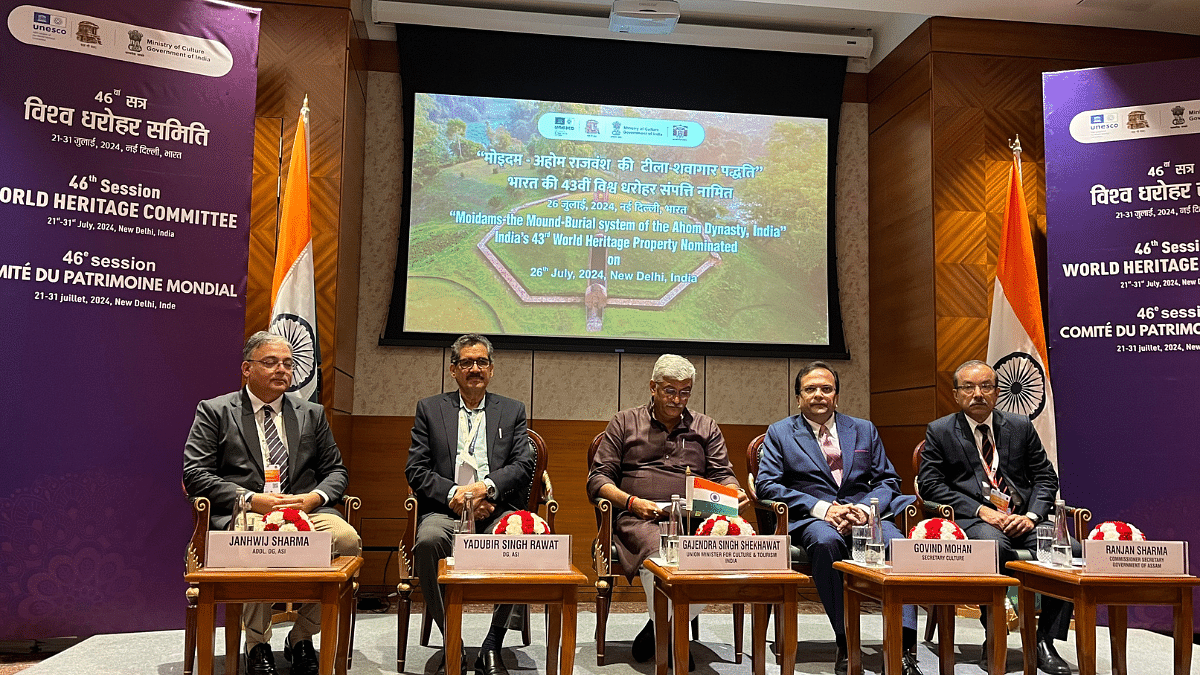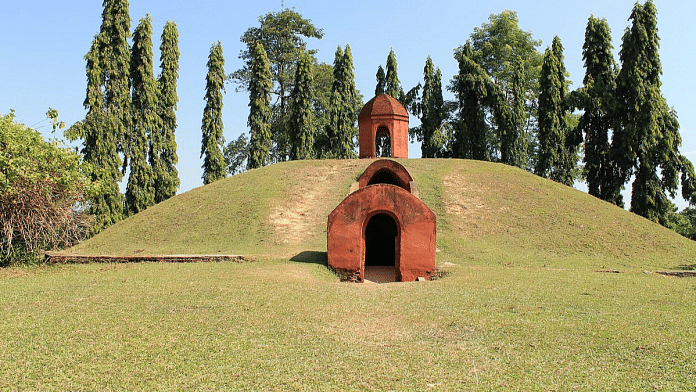New Delhi: At a press conference at Delhi’s Bharat Mandapam Friday, Union Minister for Culture and Tourism Gajendra Singh Shekhawat announced that India’s nomination for the UNESCO World Heritage List, the 700 year-old Charaideo Moidams in eastern Assam, has been accepted by the World Heritage Committee.
“This is a day of great pride for us. We expect tourism and sites around the moidams to be given a great boost,” he said. “Our multi-diverse culture will be exhibited once again.”
The moidams are an Ahom-era burial system, as well as the resting place of Ahom kings. India submitted the dossier proposing their inclusion in UNESCO’s World Heritage List three years ago.
They are India’s only nomination to the World Heritage List, becoming the 43rd site from India to find a place in the list. What makes the nomination significant is that the ‘pyramids of Assam’, as they are also known, are the first set of cultural properties from the Northeast region to make it to the list.

The moidams are currently overseen by the Archaeological Survey of India (ASI) in collaboration with the state government’s Directorate of Archaeology. Work is also underway to build a ‘site museum’ at the site of the moidams, as is recommended by UNESCO.
“We are proud of our history and of our warriors. Under the stewardship of Narendra Modi, Ahom rulers have been celebrated,” Shekhawat said, referring in particular to Lachit Borphukan, an army commander of the Ahom kingdom (1228-1826) best known for defeating the Mughals and preventing the expansion of the empire into the region.
Borphukan, in particular, has seen a massive resurgence in representation and popularity, as encouraged by the Modi government.
His birth-anniversary is celebrated by the government with gusto, said Shekhwat. “This is a very important day for all of us, and for the government of Assam.” He further noted that the dossier by India faced no opposition from any member of the global community.
Though Shekhawat and other members of the culture ministry refused to give details on the historical, cultural, or natural site that will qualify as India’s next nomination, the minister did mention the historical significance of the Maratha military landscapes, their strategic locations.
The majority of them are situated in the Sahyadri hills of Maharashtra, while there is also a fort of value in Tamil Nadu.
He also added that the Indian government has six nomination dossiers ready and waiting backstage. “If we wanted we could submit 10 by this evening itself,” he said. Other than sites which have already been nominated, there are a total of 57 sites on India’s tentative list of nominations. These come from across the spectrum, ranging from cultural to natural.
Although, at the 46th session of the World Heritage Committee in Delhi Monday, delegates from multiple countries spoke about how the separation between the two categories cannot be as sacrosanct as it presently is.
One of the major themes of this year’s conference is the need to highlight underrepresented countries.
About 20 percent of this year’s nominations are due to come from Africa. Keeping in line with this, Shekhawat also said India would highlight “areas that are deprived and haven’t been represented culturally,” calling the moidams a “classic example” of a neglected site.
Also Read: ‘Golden era of modern Assam’ or ‘bid to impress BJP brass’? Behind Himanta’s local culture push
‘Proactive approach to bringing back artefacts’
Aside from the nomination, an agreement was also signed between India and US for the repatriation of cultural assets from the US to India. As of now, India has welcomed over 300 such artefacts and objects from various countries, some of which are on display at Bharat Mandapam.
Nataraja, a metallic sculpture dating back to the Chola period, and Sri Devi, another metallic sculpture dating back to the Chola period, are some of the artefacts that have been successfully repatriated back to India.
“This has been an integral element of the Modi era. The government is committed to this decision, and we have a proactive approach to bringing back artefacts,” he said. “These are bolsters in our fight against the illicit trafficking of cultural property.”
US Ambassador to India, Eric Garcetti, highlighted the US’ commitment to repatriation.
“These are civilisations that have been around for much longer than the first Americans,” he said. “The returning of items symbolises justice.”
Neither party disclosed details of which artefacts are due to be returned.
However, there is a list of 297 items, the repatriation of which is going to be “a continuous process”.
Shekhawat called the agreement “general,” confirming that it was not for specific items. He also announced that museums dedicated to repatriated artefacts will soon be built across the country, including in Delhi.
(Edited by Amrtansh Arora)
Also read: Israeli officials, Palestinian delegation to arrive in Delhi for UNESCO event hosted by India




